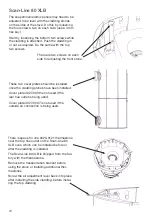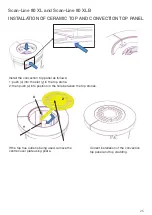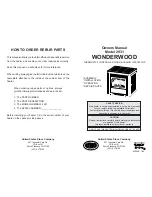
10
troubleshooting table - applies to all stove types
Fault
Cause
Troubleshooting
Solution
Lighting problems. When the
stove is cold, smoke seeps
into the room. Once the com-
bustion chamber has heated
up, the stove burns well.
Inadequate chimney draft.
The chimney only has
sufficient draft when it is hot.
You can test using a lighter whether
flame is drawn into the combustion
chamber.
Improve the chimney.
The stove burns poorly after
the warm-up phase, and the
glass slowly soots up.
Soot in the flue pipe.
Check the flue pipe regularly, as the
problem arises slowly.
Clean regularly, and limit the use
of horizontal flue pipes. Do not use
firewood which generates large
quantities of ash.
If the stove burns poorly
after start-up, and the
glass slowly soots up.
Inadequate chimney draft.
The fault usually already occurs during
lighting. Measure the chimney draft.
Improve the chimney draft.
Insufficient air supply.
Check the air supply.
Read the operating instructions and
instruct all users.
Damp wood.
Use clean, dry wood with a maximum
moisture content of 20%.
Firewood should ideally be dried for
at least one year after splitting.
Firewood pieces too large.
Optimal size – see the section for
firewood, max. diameter 10 cm.
Use smaller pieces of firewood.
Insufficient air supply to the
room. Range hoods, airtight
windows, etc.
Ensure there is sufficient fresh air
supply, open a window, check the
outdoor air supply.
Depending on the cause, windows
must be opened or the outdoor air
connection cleaned.
Insufficient air supply to the
room. Range hoods, airtight
windows, etc
Ensure there is sufficient fresh air
supply, open a window, check the
outdoor air supply.
Depending on the cause, windows
must be opened or the outdoor air
connection cleaned.
The vermiculite in the com-
bustion chamber is becoming
very worn.
Wood and flue gases wear
down the vermiculite.
Investigate whether the wear is
normal.
Normal wear and minor cracks are of
no significance. It should be replaced
when the steel of the combustion
chamber is visible.
Too rapid combustion.
Too much chimney draft.
To test, you can open the cleaning
hatch, but remember to close it again.
Measure the chimney draft and install
a damper in the flue pipe if necessary.
The door or ash pan/drawer
seal is defective.
While cold, close a piece of paper in
the door – the seal should hold the
paper gently in place so it does not
fall out by itself. Normal wear.
Replace the seal.
The vermiculite in the
combustion chamber is
cracked.
Shocks or impacts while
adding firewood.
Normal wear
Cracks only have cosmetic signifi-
cance. Replace when the steel of the
combustion chamber is visible.
Steel surfaces in the
combustion chamber
have oxidised.
The temperature in the
combustion chamber is
too high.
Unsuitable fuel is being used (such as
coal). Check the quantity of firewood
being used, read the operating in-
structions.
If there are clear cracks or weak-
nesses in the stove body, it must be
replaced.
The stove whistles
Too much chimney draft
To test, you can open the cleaning
hatch, but remember to close it again.
Install a damper.
The stove 'clunks'
Usually due to tension in the
metal plates.
Generally only occurs while heating up
and cooling down.
Adjust the metal plates.
The stove ticks
Normal expansion and
contraction due to
temperature changes.
A normal sound.
Ensure that the temperature in the
combustion chamber is as constant
as possible.
The stove creaks.
The temperature in the com-
bustion chamber is too high.
Use less firewood. Also check the seal
in the ash pan/drawer.
See the operating instructions.
The stove smells.
The surface is steaming.
The paint on the stove sur-
ace is not yet fully hardened.
See the operating instructions
regarding the first firing.
Ensure there is sufficient ventilation.
Condensation in the
combustionchamber.
Moisture in the vermiculite.
Check the condition of the vermiculite.
Evaporates by itself after the stove has
been lit a few times.
Damp wood.
Measure the moisture content.
Use dry firewood.
Condensation from the flue
pipe.
The pipe is too long or the
chimney is too cold.
Check the flue pipe's length and heat
loss.
Improve the flue pipe, insulate the
chimney.
Damp wood
Measure the moisture content.
Use dry firewood.
Moving parts creak.
Needs lubercation.
What part .
Lubercate with graphite spray.
Summary of Contents for SCAN-LIINE 80 XL
Page 18: ...18 scan line 80 Xl and scan line 80 XlB ...
Page 28: ...28 ...











































